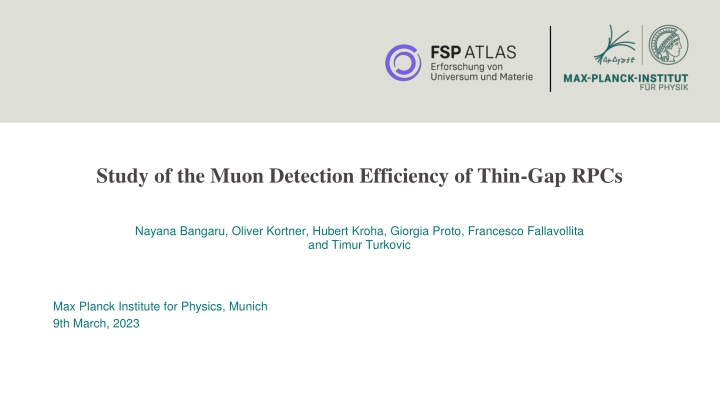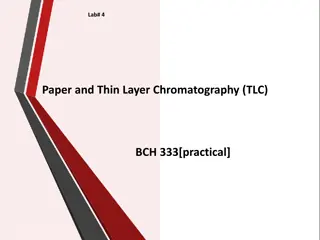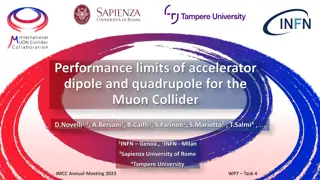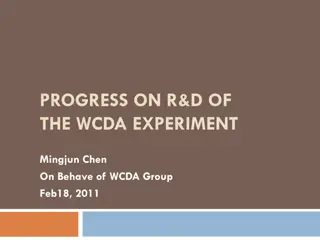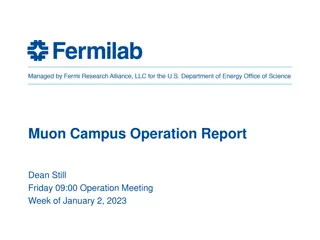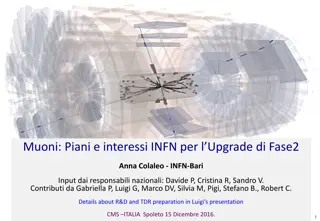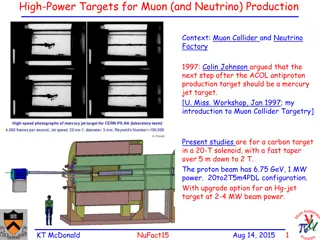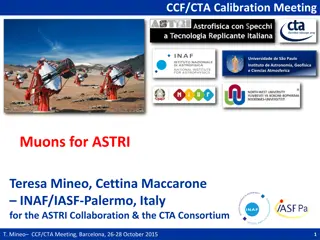Study of Muon Detection Efficiency in Thin-Gap RPCs
Conducted at the Max Planck Institute for Physics in Munich, this study focuses on the detection efficiency of thin-gap Resistive Plate Chambers. The research explores the construction, working principles, and experimental setup of RPCs, emphasizing the need for sensitive frontend electronics for high-rate capability. Various parameters affecting rate capability and induced charge reduction are investigated, along with the importance of signal-to-noise ratio in electronics. The experimental setup includes details on gas mixture, triggering logic, and strip panel with frontend electronics. Overall, the study aims to enhance muon detection efficiency in RPCs for applications in high-energy physics experiments.
Download Presentation

Please find below an Image/Link to download the presentation.
The content on the website is provided AS IS for your information and personal use only. It may not be sold, licensed, or shared on other websites without obtaining consent from the author.If you encounter any issues during the download, it is possible that the publisher has removed the file from their server.
You are allowed to download the files provided on this website for personal or commercial use, subject to the condition that they are used lawfully. All files are the property of their respective owners.
The content on the website is provided AS IS for your information and personal use only. It may not be sold, licensed, or shared on other websites without obtaining consent from the author.
E N D
Presentation Transcript
Study of the Muon Detection Efficiency of Thin-Gap RPCs Nayana Bangaru, Oliver Kortner, Hubert Kroha, Giorgia Proto, Francesco Fallavollita and Timur Turkovic Max Planck Institute for Physics, Munich 9th March, 2023
Resistive Plate Chambers Construction and Working Avalanche signal Streamer signal Parallel plate gaseous ionization detector Use of highly resistive electrodes for high rate capability and time resolution High voltage applied to graphite layer Operation in avalanche mode increases rate capability Avalanche and streamer signals from a readout strip of RPC [1] 07/09/2024 | Study of the Muon Detection Efficiency of Thin-gap RPCs 2
Thin Gap Resistive Plate Chambers Need for sensitive and fast frontend electronics bulk resistivity - High rate capability required for High Luminosity LHC - Rate capability can increased by varying various parameters - Induced charge is reduced - Sensitive electronics with high signal to noise ratio is needed total thickness average charge delivered per count 2mm 1mm 1mm 0.5mm 16mV 11mV 10ns 5ns 7mV 6ns Amplified and non-amplified efficiency curves for different gap sizes [2] Prompt signals of different gap sizes [2] 3 07/09/2024 | Study of the Muon Detection Efficiency of Thin-gap RPCs
Experimental Setup Gas Gap Gas Gap - 1 mm gap - 1.2 mm bakelite electrode - 260 k /m outer graphite coating - Copper contacts to the bakelite with silver paint - Inner surface coated with linseed oil varnish - 40 x 50.5 cm 5000kV Gas Mixture: - 4 liters/hr (5.3 liters/hr) of CH2FCF3 - 0.473% (0.025 liters/hr) of SF6 - 4.73% (0.25 liters/hr) of C4H10 Voltage Current Curve 07/09/2024 | Study of the Muon Detection Efficiency of Thin-gap RPCs 4
Experimental Setup Trigger Logic Cosmic muons Scintillator Hardware trigger: Two Scintillators : 9 cm x 100 cm x 4.5 cm Oriented perpendicular to each other Coincidence of both Region of Interest : 9 cm x 4.5 cm Trigger rate: ~ 1 Hz Effective detection area Faraday Cage Strip panel Gas gap Software trigger: Scintillator centered above strip: 6.5 cm x 32 cm x 2.5 cm Positioned over one strip Scintillators 07/09/2024 | Study of the Muon Detection Efficiency of Thin-gap RPCs 5
Experimental Setup Strip Panel and Front-End Electronics Strip Panel: 16 strips 2.8 cm wide readout strip 0.8 cm wide ground line in between Termination with 12 ohm resistor 400mV 500mV Reflected signal Example of signal pile up without termination Front-End Electronics Current Front End Electronics: Integrator circuit Bandwidth between 10MHz and 100MHz Strips Test Circuit: Transimpedance amplifier Gain bandwidth of 8 GHz Resistors Strip Panel 07/09/2024 | Study of the Muon Detection Efficiency of Thin-gap RPCs 6
Experimental Setup Operational Amplifiers Schematic of current front-end amplifiers 07/09/2024 | Study of the Muon Detection Efficiency of Thin-gap RPCs 7
Operational Amplifier OPA855 Characteristics: Can be configured as a transimpedance amplifier High gain bandwidth product: 8 GHz Gain 7 V/V (stable) Low input voltage noise: 0.98 nV/ Hz Slew rate: 2750 V/ s 07/09/2024 | Study of the Muon Detection Efficiency of Thin-gap RPCs 8
Operational Amplifier Evaluation Circuit Initial gain of 7 V/V Split supply voltage range (VCC VEE) 1.6V to 2.6V Supply current, IS 19mA Min input voltage VEE + 0.2 Max input voltage Vcc 1.25 Gain of 27.67 : Rf = 2k Ohm Gain of 54.33 : Rf = 4k Ohm Output of Op-amp Output of Circuit Input Signal 07/09/2024 | Study of the Muon Detection Efficiency of Thin-gap RPCs 9
Efficiency Test Setup OPA855 Test Circuit Chamber 4.8 kV 6.4 kV Discriminator Threshold -18mV Minimum signal width 4ns Readout LEMO cable LEMO cable LEMO cable Output gain of 27.67 07/09/2024 | Study of the Muon Detection Efficiency of Thin-gap RPCs 10
Comparison of Signals Parameters Current Front End Board OPA855 Board 5ns 20ns 100mV 100mV 4 ns - 10 ns LeCroy 4416 4 ns Length of signal Discriminator used Required length of signal above threshold Threshold level Noise level SNR ratio Availability of amplifier 20 ns - 40 ns LeCroy 620CLR 5 ns -18 mV 5 mV 8 Commercial -50 mV 30 mV 4.33 Custom made 07/09/2024 | Study of the Muon Detection Efficiency of Thin-gap RPCs 11
Efficiency Test Results Observations: Efficiency curve shifted to the right (~ +700V) Plateau starting at 6.4kV Inferences: With higher SNR, curve should be shifted to the left Width of signal too short for discriminator to identify 700 V Possible future designs: Same circuit with a comparator with shorter minimum signal width Change circuit to a charge integrator 07/09/2024 | Study of the Muon Detection Efficiency of Thin-gap RPCs 12
Summary Developing a new amplifier for thin gap RPCs using state of the art Op-amps Tested the performance of OPA855 on a chamber with cosmic muons Amplifier has 2 times better SNR than the current front-end electronics Future tests would include integrating a highly sensitive discriminator 07/09/2024 | Study of the Muon Detection Efficiency of Thin-gap RPCs 13
References [1] Ying, Jiali & Ye, YL & Ban, Y & Liu, H & Zhu, & Zhu, Z & Chen, Thiha & Ma, J & Qian, Sijin. (2000). Study of an avalanche-mode resistive plate chamber. Journal of Physics G: Nuclear and Particle Physics. 26. 1291. 10.1088/0954- 3899/26/8/315. [2] Aielli, Giulio & Camarri, Paolo & Cardarelli, R. & Di Ciaccio, Anna & Stante, L. & Iuppa, Roberto & Liberti, B. & Paolozzi, L. & Pastori, E. & Santonico, Rinaldo & Toppi, M.. (2016). Improving the RPC rate capability. Journal of Instrumentation. 11. P07014-P07014. 10.1088/1748-0221/11/07/P07014. [3] Cardarelli, R. & Aielli, Giulio & Camelia, Elvy & Bruno, S. & Caltabiano, A. & Camarri, Paolo & Di Ciaccio, Anna & Liberti, B. & Massa, L. & Pizzimento, L. & Rocchi, A.. (2019). RPC performance versus front-end electronics and detector parameters. Journal of Instrumentation. 14. C09023-C09023. 10.1088/1748-0221/14/09/C09023. [4] Cardarelli, R. & Aielli, Giulio & Camarri, Paolo & Di Ciaccio, Anna & Stante, L & Liberti, B. & Paolozzi, L & Pastori, E & Santonico, Rinaldo. (2013). Performance of RPCs and diamond detectors using a new very fast low noise preamplifier. Journal of Instrumentation. 8. P01003. 10.1088/1748-0221/8/01/P01003. 07/09/2024 | Study of the Muon Detection Efficiency of Thin-gap RPCs 14
